Our Village Features.
Recently we did a project about all the historical buildings in Rusheen and on this page you will find some articles from the book we produced.
The Protestant Church
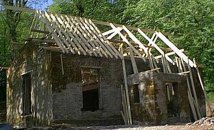 The Old Protestant Church was the first place we visited on our Heritage Trip. It is situated in Cusheen Wood. This wood gives Rusheen its name because the Irish for Rusheen is "Rúisin" and this means "little wood". The Building was in bad repair until recently. When we visited there were builders working. We met the owner, Mrs Claire Coleman, and we were delighted to get a guided tour. Now it is going to be used as a dwelling house and a B&B.
The Old Protestant Church was the first place we visited on our Heritage Trip. It is situated in Cusheen Wood. This wood gives Rusheen its name because the Irish for Rusheen is "Rúisin" and this means "little wood". The Building was in bad repair until recently. When we visited there were builders working. We met the owner, Mrs Claire Coleman, and we were delighted to get a guided tour. Now it is going to be used as a dwelling house and a B&B.
The walls which are the original ones, were built with stone and are in very good condition. There is a new slate roof being put on now The Church consisted of one big room and a porch. There was a fire-place in the big room to heat up the church. What impressed us most about the church was the beautiful stonework of the walls. Also the windows are wider outside than inside. The lintels of the doors and windows are made of a number of flat stones fitted together to make an arch.
The Church was the center of worship for the landlords and other Protestants who lived in the area. The most prominent of these would have been the Woodleys from Leeds House, Radleys from Rockville, Brodericks from Kilberrihert House and the Bowens from Hanover Hall. When the Church closed some of its pews were donated to the local Catholic Church in Rusheen and can still be seen there today.
Local tradition has it that one of the carpenters who worked on the building of the church was Philip Allen. He was one of the Manchester Martyrs who was hanged at Manchester in 1867 along with Larkin and O'Brien for the killing of a police sergeant during a raid on a prison van. The Manchester Martyrs were part of "The Fenians", a militant group who tried to win independence for Ireland in a failed rising in 1867.
The Forge
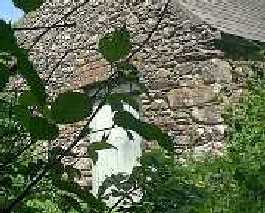
|
This is a photo of the forge taken by us on our heritage trip ,March 2001
|
The forge is situated just South of the School in Rusheen. It is now disused but is owned by Mr. O Connor who lives nearby. It is a beautiful, old stone building but none of the tools remain there. The Blacksmith that worked in the forge long ago was Den Linehan. Up until the 1960's the forge was very essential in rural communities, as the services of the Blacksmith were required by nearly every member of the community in which he worked. The blacksmith's jobs varied: he shod horses, but he also made troughs, tools for the community, cranes and hooks for fireplaces, spades, sickles, scythes and also gates.
The work of shoeing the animals began by the reddening of a thin iron bar on a fire of slack coal on a hob, which would be kept alight by the turning of a handle on a bellows. The iron would then be beaten into the required shape on an anvil and cut if necessary to the desired length using a chisel and a hammer or sledge. Holes would then be made in the shoe for the nails to be put through. The shoe would then be reddened on the fire and placed on the animals hoof and it would burn its shape onto the hoof. The shoe was then cooled in water and the animals hoof pared. Then the shoe was carefully nailed to the horses hoof.
The forge was a good meeting place and all the local social issues would have been discussed there. Money was is short supply in those times and payment was often a form of bartering i.e. a sack of potatoes or a piece of meat might be given by the person requiring the services of the blacksmith.
Rusheen Catholic Church
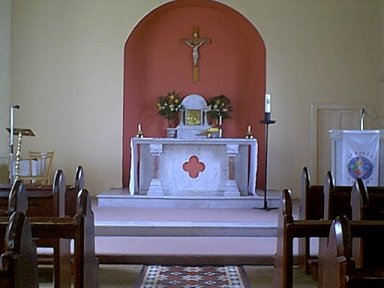 Rusheen Catholic Church is in the townland of Kilberrihert. It is a small Church and is one of three in the Parish of Aghinagh. Why a Parish as small as Aghinagh would have three Churches cannot be explained unless we examine our ancient history going back to the 1840s. Then there was no Church in Rusheen.
Rusheen Catholic Church is in the townland of Kilberrihert. It is a small Church and is one of three in the Parish of Aghinagh. Why a Parish as small as Aghinagh would have three Churches cannot be explained unless we examine our ancient history going back to the 1840s. Then there was no Church in Rusheen. In the townland of Aughinida near Rusheen was a little tatched Chapel where the local people worshipped. This Chapel was situated on the Shanakiel side of the Barracks Cross. Eventually this little Church fell into disrepair and a new Church was proposed to serve the needs of Rusheen and Ballinamorrive. Fr. Pierse Green was the Parish Priest at this time and a site was offered to him in Ballinamorrive. A Church built here would suit the people quite well, but the people of Rusheen protested that it was too far from them. However, work commenced on the new Church in Ballinamorrive. So annoyed were the people of Rusheen that they attached the partly built Church. They were driven off, but returned in force sometime later and a battle took place between the two factions. All kinds of weapons were used and one of the attackers was stabbed. The walls were razed to the ground and the building abandoned. Two of the attacking families were excommunicated and there were a number of court cases which made the headlines of the local newspapers.
During this time, the people of Rusheen did not recognise Fr. Green as P.P. and had a suspended Priest named Fr. Mulholland doing duty for them. The issue was finally settled by the building of two Churches, one in Ballinamorrive and one in Kilberrihert for the Rusheen people. The site for the Church in Kilberrihert was given by a local Protstant Landlord, Mr. Cooper.
Our Pitch
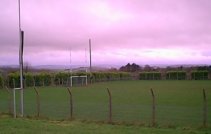 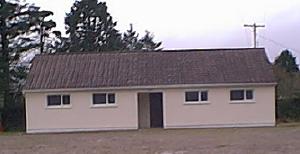
|
|
In the frame above are photos of our pitch and dressingroom
The Pitch is situated in the townland of Kilberrihert but is generally referred to as Rusheen Pitch. The pitch is owned by Aghinagh G.A.A. club. Aghinagh G.A.A. was in existence almost as soon as the GAA was founded in 1884. There is reference to Aghinagh playing Hurling in the 1880's and they defeated Donoughmore in the County Championship in 1889. In 1900 Aghinagh hurling team was graded senior and beat Blackrock in the first round of the County. Dungourney beat them in the County Semi-Final. Football apparently was the preferred game in the early 1900's. Aghinagh played the Nells in 1905 and these were a very strong team in Cork at the time. The Club didn't seem to function for some time after this and the Club as we know it now was founded in 1949 in Bawnmore. Football was now the only game played and many great efforts were made to win the Mid-Cork Championship in the 1950's but all to no avail. In the 1960's the Club again ceased to function for some time.
Fortunes were reversed in 1969 when Fr. Anthony Cronin became the Curate in Aghinagh and got the Football Club going again. Aghinagh won their first ever Juvenile Championship in 1970 and have never looked back since. Their first adult championship title was captured in 1973 when they won the Junior B Title for the first time to the great joy of their supporters. That year also Vincent Coakley played for the Cork Minor Football Team which was a great honour for the Club. The Junior B title was captured again in 1980 and from there on great efforts were made to win the Junior A title. Finals were reached in 1992 and 1995 but not
won.
In 1984 Aghinagh G.A.A. bought their pitch at a price of £15,000 from Dan O'Callaghan in Kilberrihert and in subsequent years £50,000 more was spent in developing the field, building dressing rooms and installing a flood lighting system. Another milestone for the club was Ger O'Leary's presence on the Cork Minor Team of 1993 which won the All-Ireland Title. In the 1990's the Hurling Club was revived and they play at Junior B level.
Presently the club caters for an average of five adult teams and five juvenile teams. It costs a lot of money to run the Club and fundraising usually takes the form of an annual Club Raffle after Easter and the County Board Draw.
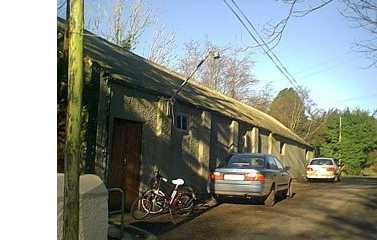 |
The Hall
The question of how the parish hall came to be has often been asked. It's location was decided at a meeting in Bealnamorrive on 13th February, 1950. In the 1940's Muintir na Eire, under the guidance of its founder, Conan Hayes of Bansha, founded parish councils in most rural areas. In 1947 the clergy then in our parish, Fr. Twomey P.P. and Fr. Driscoll C.C., decided that a guild or a parish council would be a good idea in Aghinagh. The parish council in discussing the provision of a meeting place at first decided to purchase a nissen hut and in fact had almost bought a hut in Dublin for £65 plus carriage of £11 but eventually decided to erect a more substantial structure. A public meeting was held in Bealnamorrive. At this meeting a proposal that a hall be built in Rusheen was put forth. The site was three or four feet under road level. It required an enormous amount of stones to bring it up to road level. Despite an all out campaign to raise money for the fund the council was still far short of the amount needed. So it was decided to raise a loan. Allied Irish Bank refused but the Bank of Ireland agreed a loan of £200 provided that five guarantors with a valuation of over £5 could be got. A gala opening cermony was held on the third Sunday of December 1950. Delegates were present from all parishes in the Mid-Cork area. Subsequently in Fr. Hegarty's time extensions and alterations were carried out.. |
The Creamery
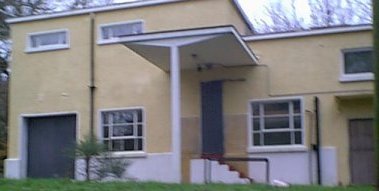
The creamery is situated at a fork in the road, above Coopers Cross, in the townland of Rusheen . It was built in the 1930's. It is no longer used as a creamery having been closed down in the early 1970's. In its hey-day all the local farmers brought their milk to Rusheen creamery. In the earlier times , the milk was brought by donkey and cart, then as the farmers grew richer milk was brought by horse and cart and eventually by tractors and trailers. The farmers' milk was brought in churns. The milk was poured into a big tank to be measured and the farmers were paid for their milk at the end of the month. The farmers could also buy feed for their animals in a separate shed. Afterwards, farmers could go to the shop nearby. Here they could buy bread, newspaper etc. and have a chat with other farmers. It was a great social occasion for them.
When the creamery was closed, it lay unoccupied for some time. However, it was then bought by Adrian Lacey-Porter and John Pettey and they set about developing "Tribarac Recording Studios". Now the upstairs of the creamery has been converted into a state of the art 48- track digital recording studio. Downstairs has been developed as a multi-use rehearsal facility with a stage, available for hire as a work-shop, party or function space for 100 plus people. The studio is connected to the World Wide Web allowing access to millions of sound effects.
The R.I.C. Barracks
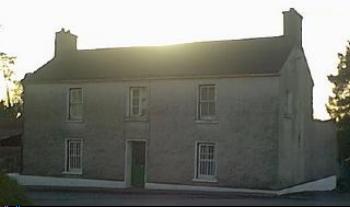
The Barracks Cross is in the Southern part of Rusheen .It gets it's name from the R.I.C. Barracks that stands there .This building is now used as a dwelling house by Mr. John Leary and his brother Dan Leary .There are still bars on the bottom two windows .The officers lived there and the patrolled the area . They would have been particularly busy at the time of the great trouble during the building of the new Church in Rusheen. You can read all about it in our article on Rusheen Catholic Church.
It is a two storey house 15 meters long and 13 metres wide. There is a high wall built at the back of the house and a farmyard beside it .It is built near a Protestant Church.
Eileen's Shop
This is a picture of Eileen's shop, it is the only shop in Rusheen. It is by the church. It sells sweets, drinks, bread and milk. We go in there after mass every Sunday.Eileen lives in there as well.The shop is by the river.










